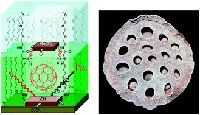Fullerene size matters
How does the reactivity of metallofullerenes correlate with the size of the cage?
Advertisement
Luis Echegoyen and co-workers at Clemson University, US and Luna Innovations Inc., Danville, Virginia have uncovered the reactivity of the higher trimetallic nitride endohedral metallofullerene cages (TNT EMF). Endohedral metallo fullerenes (EMF) are fullerenes that have metal atoms enclosed within their inner spheres. The US scientists explain that as the fullerene cage gets larger, the HOMO-LUMO gap decreases so that the reactivity also decreases.
In order to demonstrate how the size of fullerene cages affect the reactivity of the cyclopropanation reaction with bromomalonate also known as the Bingel reaction, Echegoyen compared the reactivity differences of Gd3N@C80, Gd3N@C84 and Gd3N@C88. They found that Gd3N@C80 gives rise to a mono- and bis-malonate adduct with apparent regioselectivity. Gd3N@C84 gives solely a mono-malonate adduct, while Gd3N@C88 which has the smallest HOMO-LUMO gap, is completely unreactive. 'Up to now, there have been no reports of the reactivity of the higher TNT EMF cages (larger than C80)', says Echegoyen.
Echegoyen and colleagues believe that new types of MRI contrast agents based on these TNT EMFs will soon be available. The US team is currently working on placing different functional groups (beyond the diethyl malonates described in this work) on the fullerene cages which will impart the desired water solubility required for MRI contrast agents.
Original publication: Manuel N. Chaur et al., Chem. Commun., 2008.
Organizations
Other news from the department science

Get the chemical industry in your inbox
By submitting this form you agree that LUMITOS AG will send you the newsletter(s) selected above by email. Your data will not be passed on to third parties. Your data will be stored and processed in accordance with our data protection regulations. LUMITOS may contact you by email for the purpose of advertising or market and opinion surveys. You can revoke your consent at any time without giving reasons to LUMITOS AG, Ernst-Augustin-Str. 2, 12489 Berlin, Germany or by e-mail at revoke@lumitos.com with effect for the future. In addition, each email contains a link to unsubscribe from the corresponding newsletter.


























































